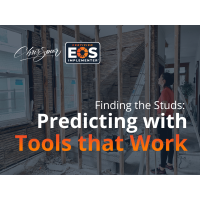Finding the Studs: Predicting with Tools that Work
Over the weekend, I tackled a project that reminded me how closely home improvement mirrors leadership. I hung five large bookcases in my home office — not lightweight display shelves, but serious bookcases meant to hold heavy books. That meant they needed strong, secure anchors in the wall. Drywall alone wouldn’t cut it; I had to hit the studs.
But I couldn’t see the studs. They sat hidden behind the wall, out of sight. So I grabbed my trusty stud finder — a small tool that promises to detect those strong, supportive beams. I trusted the tool. It beeped. I drilled. One by one, I anchored the bookcases with confidence because I believed in what the tool told me.
That process reminded me of the EOS Leadership Ability “Predict.” As leaders, we also face situations where we can’t see everything. We make decisions based on what we believe is true. EOS gives us tools — like my stud finder — that help us predict what’s solid and trustworthy so we can act with confidence and avoid costly mistakes.
Predicting with Rocks
In EOS, Setting Rocks is a tool… not just a series of important things to work on. When we follow the Rock process to predict where we need to focus our energy each quarter, we don’t guess. Instead, we follow a repeatable process:
- We review the V/TO (Vision/Traction Organizer) to realign around our long-term goals.
- We reflect on last quarter’s Rocks to evaluate whether we made the changes we committed to… and even if we did it’s often clear what we need to do next.
- We scan our Issues Lists — long-term and short-term — to uncover what’s holding us back or what needs transformation.
This process reveals where we can make the biggest impact in the next 90 days. We don’t base our quarterly priorities on instinct alone — we use the tools to identify where we’ll get the best results. It’s like scanning the wall for a stud: we rely on the method to tell us where to drill.
Seeing Trends with the Scorecard
The Scorecard gives us another way to predict. It shows us weekly, measurable data that tracks our progress toward key goals. We see trends. We spot problems before they explode. The Scorecard gives us the visibility we need to act early — while there’s still time to adjust.
Just like lining up a screw where the stud finder beeped, the Scorecard gives me the confidence to move forward, even though I still can’t see the “stud.” I won’t know for sure until I take action, but the data gives me the best shot at hitting something solid.
Hiring with the People Analyzer
The People Analyzer helps us predict whether someone will succeed in a role. We don’t rely on gut feeling. Instead, we evaluate whether they align with our Core Values and whether they Get it, Want it, and have the Capacity to do the job.
If someone looks good on paper but doesn’t align with the culture, they won’t support the weight of the role. Just like drywall can’t hold a heavy bookcase, the wrong hire will crack under pressure. And when that happens, the damage goes deeper than one broken shelf — it creates holes and broken chaos that you have to clean up.
Predict With Core Processes: Followed by All
When every team member follows the same documented Core Processes, we create predictability across the organization. We know what to expect. We can deliver consistent results to our clients. When people ignore the process, it’s like drilling holes randomly across the wall, hoping to get lucky. Maybe you’ll hit a stud — maybe you’ll leave a mess of holes that need patching. Strong processes help us predict profitability and client satisfaction
The Tools Help You Predict. Predicting Helps You Win.
When I hung those bookcases, I trusted my stud finder to guide each anchor point. I didn’t drill blindly, and I didn’t guess. I used a tool designed to help me predict what I couldn’t see — and it worked.
EOS gives us the same kinds of tools. When we use them — Rocks, the Scorecard, the People Analyzer, and Core Processes — we stop reacting and start leading with intention. We make fewer mistakes. We cause less damage. And we build something solid.
What’s Next?
If you want to predict well, let me show you how to use the right tools. “The answer is in the Tools.”
Chris Spear - Certified EOS Implementer
-
Chris Spear Founder
- July 08, 2025
- (480) 848-3037
- Send Email


